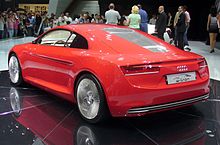Audi e-tron Frankfurt
| Audi | |
|---|---|

World premiere of the Audi e-tron at the IAA 2009 |
|
| e-tron | |
| Presentation year: | 2009 |
| Vehicle fair: | IAA |
| Class : | Sports car |
| Body shape : | Coupe |
| Engine: |
Electric motors : 150–230 kW |
| Length: | 4260 mm |
| Width: | 1900 mm |
| Height: | 1230 mm |
| Wheelbase: | 2600 mm |
| Empty weight: | 1600 kg |
| Production model: | none |
The Audi e-tron (also e-tron Frankfurt Showcar ) is an electric car that was first presented at the IAA 2009 and developed by Audi . It belongs to the e-tron brand .
overview
In contrast to most newer electric cars, the e-tron is a sports car. Its design is based on that of the R8 , but looks more futuristic.
The e-tron accelerates from 0 to 100 km / h in 4.8 seconds, and it takes 4.1 seconds for the intermediate sprint from 60 to 120 km / h. The manufacturers limited the maximum speed to 200 km / h to protect the battery. The maximum range is 248 km.
The frame of the 1,600 kg car is made of aluminum and the shell is made of carbon fiber reinforced plastic (CFRP).
technology
engine
The Audi e-tron (Frankfurt show car) has a total of four asynchronous motors , one per wheel. Depending on requirements, a different torque can be applied to each wheel. All four motors together generate an output of 230 kW and approx. 450 Nm of torque. The Audi e-tron (Detroit show car) has two asynchronous motors and a torque of 2650 Nm.
accumulator
The lithium-ion battery is installed behind the seats on the e-tron . It weighs 470 kg and has a nominal capacity of 53 kWh, although only 42.4 kWh can be used. It takes six to eight hours to fully charge the battery at a household socket, while a high-speed charging station shortens the process to 2.5 hours. A cable can be found in the rear as an interface.
technical features
The e-tron is equipped with a number of new technical developments. The recuperation , which is already used in other electric cars, can also be found here. However, electromechanical brakes that work completely without hydraulics increase the efficiency of this technology. In addition, a heat pump is being used for the first time in a car, using the heat given off by the engines for heating. The e-tron's coolers are variable and only open when necessary for cooling.
Other versions

Another version of the e-tron was presented at the North American International Auto Show 2010. The e-tron Detroit show car is more compact and less powerful than its Frankfurt counterpart. To this end, more emphasis was placed on the interior and innovative operating concepts via smartphone.
At the Geneva Motor Show was the Audi A1 e-tron presented. This is a hybrid version of the A1 with a 75 kW electric motor and a rotary engine as a so-called range extender .
The Spyder study was presented at the 2010 Paris Motor Show. The design of the cabriolet is based on that of the e-tron from Frankfurt. From a technical point of view, however, the Spyder is a plug-in diesel hybrid car . Thanks to the interaction of a three-liter six-cylinder diesel engine with 221 kW and two electric motors with a total of 64 kW, which work on the front axle, the 100 km / h limit should be reached in 4.4 seconds. The standard consumption should be 2.2 liters of diesel per 100 km.
The latest concept in the series was finally presented at Auto Shanghai 2011. The A3 e-tron Concept is once again a plug-in hybrid, consisting of a 1.4-liter TFSI engine (155 kW / 211 PS) and an electric motor with 20 kW. The system output of the sedan is therefore 175 kW (238 hp).
Web links
- Description of the e-tron on audi.de.
- Article of the morning mail
- Report on Greencarcongress.com
- Driving report on sueddeutsche.de
Individual evidence
- ↑ audi.de: ( Memento from May 15, 2013 in the Internet Archive ) Technical data of the Audi e-tron Frankfurt
- ↑ audi.de: ( Memento from May 15, 2013 in the Internet Archive ) Technical data of the Audi e-tron Detroit
